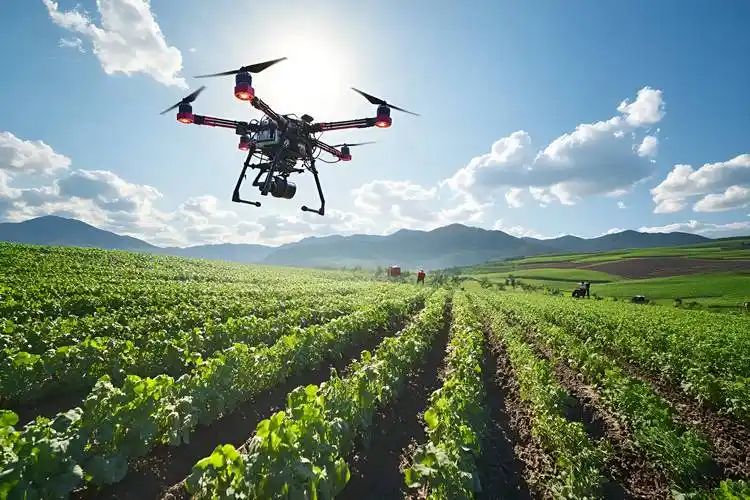Global Drone Agricultural Services Market Size Estimated at USD 2,347 Million by 2024
Tuesday,21 Jan,2025
According to the industry report, the global drone agriculture services market size is estimated at USD 2,347 million in 2024 and is expected to reach USD 3,335 million by 2031, growing at a CAGR of 5.0% during the forecast period of 2025-2031.
Drone Agricultural Services (DAS) By providing efficient crop monitoring, precision application, and data collection, agricultural drones help farmers increase yields, reduce resource waste, and promote sustainable agricultural practices.
There are various applications of drones in agriculture, mainly including:
Crop monitoring: drones are equipped with high-resolution cameras and multispectral sensors that can monitor crop growth in real time. Farmers can analyze this data to identify crop health issues, water stress, pests and diseases, and more. For example, a study supported by the U.S. Department of Agriculture (USDA) showed that using drone monitoring can advance the detection of pests and diseases by 10-14 days.
Precision application: drones spray pesticides or fertilizers with far greater precision than traditional methods. Not only does it reduce the amount of chemicals used, it also reduces the impact on the environment. According to a 2024 study in the Journal of Agricultural Science and Technology, spraying with drones can reduce pesticide use by 20 to 30 percent.
Land mapping and management: drones are used to generate high-precision land maps that help farmers with land management, irrigation planning and harvest forecasting. Such data support makes agricultural decisions more scientific and efficient.

North America leads the global market due to its high acceptance of technological innovations and automation in agriculture. Asia Pacific, on the other hand, is expected to be the fastest growing market due to growing population and increasing demand for food. Increasing number of companies offering Drone-as-a-Service (DaaS) has lowered the barrier of entry for drone technology and attracted more small-scale farmers to use drone technology.
Artificial Intelligence and Machine Learning, AI technology is used for image recognition and data analysis to provide instant feedback on crop health. Google's Automated Farming program and DJI's Smart Farming solutions are prime examples in this area.
Battery technology, longer-lasting batteries allow drones to cover larger areas. For example, StoreDot's ultra-fast charging technology has reduced drone charging time from 90 minutes to 5 minutes, dramatically improving drone usage.
Sensor technology, a new generation of sensors, such as thermal imaging and LiDAR, can provide more detailed soil and crop data to support more precise agricultural management.
While the use of drones in agriculture is promising, clearer regulatory policies are needed to ensure safe operation and privacy protection. Integration of drones with other agricultural technologies (e.g., smart irrigation systems, robotic picking equipment, etc.) will further automate agriculture. Future drone designs will pay more attention to environmental sustainability, such as using greener materials and reducing energy consumption.
Drone Agricultural Services (DAS) By providing efficient crop monitoring, precision application, and data collection, agricultural drones help farmers increase yields, reduce resource waste, and promote sustainable agricultural practices.
Applications of Drone Agriculture
There are various applications of drones in agriculture, mainly including:
Crop monitoring: drones are equipped with high-resolution cameras and multispectral sensors that can monitor crop growth in real time. Farmers can analyze this data to identify crop health issues, water stress, pests and diseases, and more. For example, a study supported by the U.S. Department of Agriculture (USDA) showed that using drone monitoring can advance the detection of pests and diseases by 10-14 days.
Precision application: drones spray pesticides or fertilizers with far greater precision than traditional methods. Not only does it reduce the amount of chemicals used, it also reduces the impact on the environment. According to a 2024 study in the Journal of Agricultural Science and Technology, spraying with drones can reduce pesticide use by 20 to 30 percent.
Land mapping and management: drones are used to generate high-precision land maps that help farmers with land management, irrigation planning and harvest forecasting. Such data support makes agricultural decisions more scientific and efficient.

Drone Services Market Trends
North America leads the global market due to its high acceptance of technological innovations and automation in agriculture. Asia Pacific, on the other hand, is expected to be the fastest growing market due to growing population and increasing demand for food. Increasing number of companies offering Drone-as-a-Service (DaaS) has lowered the barrier of entry for drone technology and attracted more small-scale farmers to use drone technology.
Technology Advances
Artificial Intelligence and Machine Learning, AI technology is used for image recognition and data analysis to provide instant feedback on crop health. Google's Automated Farming program and DJI's Smart Farming solutions are prime examples in this area.
Battery technology, longer-lasting batteries allow drones to cover larger areas. For example, StoreDot's ultra-fast charging technology has reduced drone charging time from 90 minutes to 5 minutes, dramatically improving drone usage.
Sensor technology, a new generation of sensors, such as thermal imaging and LiDAR, can provide more detailed soil and crop data to support more precise agricultural management.
While the use of drones in agriculture is promising, clearer regulatory policies are needed to ensure safe operation and privacy protection. Integration of drones with other agricultural technologies (e.g., smart irrigation systems, robotic picking equipment, etc.) will further automate agriculture. Future drone designs will pay more attention to environmental sustainability, such as using greener materials and reducing energy consumption.

